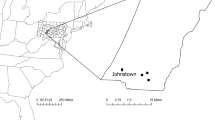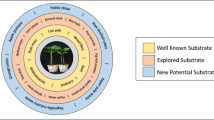Abstract
The edible mushroom Volvariella volvacea or straw mushroom is extensively cultivated throughout the year in countries with warm and humid climates. It has the potential for integration into agroforestry food production systems and support food security strategies via climate- and environmental-friendly agriculture, without adversely affecting forest ecosystems. This study aims to ascertain the effect of microclimate on the production of V. volvacea by adapting outdoor cultivation methods to logged lowland dipterocarp forests, along with the application of oil palm wastes as a growing substrate. The study measured a range of microclimatic variables including bed temperature and humidity, as well as bed orientation. Freshly processed planting material from oil palm empty fruit bunches (EFB) was partially composted using conventional open-air composting method and then used as a growing substrate. V. volvacea was cultivated on twenty planting beds composed of EFB, with north–south and east–west orientations, over 4 replication periods, between November 2017 and May 2019, and mushroom production was measured. The analysis found that bed humidity, bed temperature, harvesting week, harvesting month, and replication significantly affected V. volvacea production, while bed pH and orientation did not affect production. Varying temperature and humidity particularly during incubation, for mycelial growth and fruiting body development, as well as harvesting period, are important factors affecting mushroom production. Our study showed that lowland dipterocarp forest provide an ideal setting for cultivating edible mushrooms. Further investigation should be conducted to ascertain the potential for cultivating V. volvacea in other tropical agroforestry contexts, and to assess its potential to mitigate climate change and contribute to a circular economy through recycling oil palm wastes.




Similar content being viewed by others
References
Abdullah N, Sulaiman F, Gerhauser H (2011) Characterization of oil palm empty fruit bunches for fuel application. J Phys Sci 22(1):1–24
Ahlawat OP, Arora B (2016) Paddy straw mushroom (Volvariella volvacea) Cultivation; National Research Centre for Mushroom (ICAR): Solan, India pp. 165–182
Ahlawat OP, Tewari RP (2007) Cultivation technology of paddy straw mushroom (Volvariella volvacea); National Research Centre for Mushroom (ICAR): Solan, India pp 1–33
Akinyele BJ, Adetuyi FC (2005) Effect of agrowastes, pH and temperature variation on the growth of Volvariella volvacea. Afr J Biotechnol 4(12):1390–1395
Apetorgbor AK, Apetorgbor MM, Derkyi NSA (2015) Comparative studies on growth and yield of oil palm mushroom, Volvariella volvacea (Bull. Ex. Fr.) Sing on different substrates. Greener J Agric Sci 5(5):177–189
Belewu MA, Belewu KY (2005) Cultivation of mushroom (Volvariella volvacea) on banana leaves. Afr J Biotechnol 4(12):1401–1403
Bernama (2020) Rubber smallholders turn to mushrooming business. Available online: https://www.thestar.com.my/news/nation/2018/12/16/rubber-smallholders-turn-to-mushrooming-business. Accessed 22 Apr 2020
Biswas MK, Layak M (2014) Techniques for increasing the biological efficiency of paddy straw mushroom (Volvariella volvacea) in eastern India. Food Sci Technol 2(4):52–57
Chang ST (1974) Production of the straw mushroom (Volvariella volvacea) from cotton wastes. Mushroom J, pp 348–354
Chang ST, Hayes WH (1978) Biology and cultivation of edible mushrooms. Paddy straw mushroom (Volvariella volvacea). Academic Press, New York, pp 102–109
Chang ST, Miles PG (2004) Mushrooms: cultivation, nutritional value, medicinal effect, and environmental impact, 2nd edn. CRC Press, Boca Raton, Florida, pp 289–292
Cotter T (2014) Organic mushroom farming and mycoremediation: Simple to advanced and experimental techniques for indoor and outdoor cultivation. Windsor County, Vermont: Chelsea Green Publishing: Vermont, USA
Das TK, Sharma R Sing B (1987) Utilization of weeds and other waste products for spawn and fruiting body production of Oyster mushroom. In Sharma R (ed) Proceedings of the 8th international symposium, Bull, USA, 3–5 August 1987. US Department of Agriculture Tech.; pp 3–5
Dormann CF, Elith J, Bacher S et al (2013) Collinearity: a review of methods to deal with it and a simulation study evaluating their performance. Ecography 36(1):27–46
Gupta S, Summuna B, Gupta M, Annepu SK (2018) Edible mushrooms: cultivation, bioactive molecules, and health benefits. Bioactive Mol food, pp 1–33
He BL, You LR, Ye ZW et al (2018) Construction of novel cold-tolerant strains of Volvariella volvacea through protoplast fusion between Volvariella volvacea and Pleurotus eryngii. Sci Hortic 230:161–168
Ito T (1978) Cultivation of Lentinus edodes. In Chang ST, Hayes WA, (eds) The biology and cultivation of edible mushrooms. Academic Press, London, pp 461–473
Jamjumroon S, Wongs-Aree C, McGlasson WB et al (2013) Alleviation of cap browning of 1-MCP/ high CO2- treated straw mushroom buttons under MAP. Int Food Res J 20(2):581–585
Jang MJ, Lee YH, Liu JJ, Ju YC (2009) Optimal conditions for the mycelial growth of Coprinus comatus strains. Mycobiology 37(2):103–108
Kaushik S, Ipsita D, Kumar S (2018) Paddy straw mushroom (Volvariella spp.): a natural scavengers who help in malnutrition and environment protection. Int. J Microbiol Res 10(5):1183–1185
Le Vinh Thuc RGC, Sajor JT, Truc NTT et al (2020) Rice-straw mushroom production. In Douthwaite B, Chivenge P, Van Hung N, Gummert M (eds) Sustainable rice straw management. Springer, Cham, pp 93–109
Li N, Chen F, Cui F, Sun W, Zhang J, Qian L, Yang Y, Wu D, Dong Y, Jiang J, Yang H (2017) Improved postharvest quality and respiratory activity of straw mushroom (Volvariella volvacea) with ultrasound treatment and controlled relative humidity. Sci Hortic 225:56–64
Mahapatra N, Rahman FH, Mishra P, Sahoo TR, Mishra SN, Sahoo PK (2020) Assessment of scope and efficiency of off-season rice straw mushroom (Volvariella volvacea L.) cultivation in coastal Odisha. Curr J Appl Sci Technol, pp 28–34
Mudge K (2013) Best management practices for log-based shiitake cultivation in the Northeastern United States. University of Vermont, Extension
Nerlich K, Graeff-Hönninger S, Claupein W (2013) Agroforestry in Europe: a review of the disappearance of traditional systems and development of modern agroforestry practices, with emphasis on experiences in Germany. Agrofor Syst 87:475–492
Omar R, Idris A, Yunus R, Khalid K, Isma MIA (2011) Characterization of empty fruit bunch for microwave-assisted pyrolysis. Fuel 90(4):1536–1544
Pani BK, Das SR (2001) Seasonal productivity of paddy straw mushroom (Volvariella spp.) in Orissa. Mushroom Res 10(1)
Rajapakse P (2011) New cultivation technology for paddy straw mushroom (Volvariella volvacea), In Proceedings of the 7th international conference on mushroom biology and mushroom products (ICMBMP7) pp 446–451
Reyes RG (2000) Indoor cultivation of paddy straw mushroom, Volvariella volvacea, in crates. Mycologist 14(4):174–176
Roberts E (2017) Agroforestry for the Northeastern United States: research, practice, and possibilities. In Integrating landscapes: agroforestry for biodiversity conservation and food sovereignty, advances in agroforestry 12. Springer, Cham, pp 79–126
Rosmiza MZ, Davies WP, Rosniza-Aznie CR, Jabil MJ, Mazdi M (2016) Prospects for increasing commercial mushroom production in Malaysia: challenges and opportunities. Mediterr J Soc Sci 7(1S1):406–406
Roy A, Prasad P, Gupta N (2014) Volvariella volvacea: a macrofungus having nutritional and health potential. Asian J Pharm Technol 4(2):110–113
Royse DJ, Schisler LC, Diehle DA (1985) Shiitake mushrooms consumption, production and cultivation. Interdiscipl Sci Rev 10(4):329–335
Sakinah NM, Misran A, Mahmud TMM, Abdullah S (2019) A review: production and postharvest management of Volvariella volvacea. Int Food Res J 26(2):367–376
Schall R (1991) Estimation in generalized linear models with random effects. Biometrika 78(4):719–727
Selim SH, Zayed MS, Atta HM (2012) Evaluation of phytotoxicity of compost during composting process. Nat Sci 10(2):69–77
Singer R (1961) Mushrooms and truffles - botany, cultivation and utilization. Interscience Publishers, New York, pp 270
Singh AK, Gohain I, Datta M (2016) Upscaling of agroforestry homestead gardens for economic and livelihood security in mid–tropical plain zone of India. Agrofor Syst 90(6):1103–1112
Sreekala MS, Kumaran MG, Thomas S (1997) Oil palm fibers: morphology, chemical composition, surface modification, and mechanical properties. J Appl Polym Sci 6:821–835
Sukendro L, Gunawan AW, Dharmaputra OS (2001) Pengaruh waktu pengomposan limbah kapas terhadap produksi jamur merang. Microbiol Indones 6(1):19–22
Tee SL, Samantha LD, Kamarudin N, Akbar Z, Lechner AM, Ashton-Butt A, Azhar B (2018) Urban forest fragmentation impoverishes native mammalian biodiversity in the tropics. Ecol Evol 8(24):12506–12521
Thakur MP, Singh HK (2014) Advances in the cultivation technology of tropical mushrooms in India. JNKVV Res J 48(2):120–135
Thiribhuvanamala G, Krishnamoorthy S, Manoranjitham K, Praksasm V, Krishnan S (2012) Improved techniques to enhance the yield of paddy straw mushroom (Volvariella volvacea) for commercial cultivation. Afr J Biotechnol 11(64):12740–12748
Triyono S, Haryanto A, Telaumbanua M, Lumbanraja J, To F (2019) Cultivation of straw mushroom (Volvariella volvacea) on oil palm empty fruit bunch growth medium. Int J Recycl 8(4):381–392
Ukoima HN, Ogbonnaya LO, Arikpo GE, Ikpe FN (2009) Cultivation of mushroom (Volvariella volvacea) on various farm wastes in Obubra local government of Cross River State. Nigeria Pak J Nutr 8(7):1059–1061
Umor NA, Abdullah S, Mohamad A, Ismail S, Ismail SI, Misran A (2020) Challenges and current state-of-art of the Volvariella volvacea cultivation using agriculture waste: a brief review. In Advances in waste processing technology. Springer, Singapore, pp 145–156
Acknowledgements
The authors would like to acknowledge Ms. Siti Noor Shuhada Rajihan, Ms. Syaidatul Akmar Shahomlail, Mr. Mohamad Hazim Ismail, Ms. Nur Najma Athirah Hasim, Ms. Atikah Che Ismail, Ms. Safawati Jainuddin, and all who had been involved directly, or indirectly in assisting the field data collection. We are grateful to the Malaysian Palm Oil Board (MPOB) for the materials and manpower support that brought success to this work.
Funding
This research was funded by Universiti Putra Malaysia Grant GP-IPM/2017/9517300.
Author information
Authors and Affiliations
Corresponding author
Ethics declarations
Conflict of interest
The authors declare no conflict of interest.
Additional information
Publisher's Note
Springer Nature remains neutral with regard to jurisdictional claims in published maps and institutional affiliations.
Supplementary Information
Below is the link to the electronic supplementary material.
Rights and permissions
About this article
Cite this article
Kamaliah, N., Salim, S., Abdullah, S. et al. Evaluating the experimental cultivation of edible mushroom, Volvariella volvacea underneath tree canopy in tropical agroforestry systems. Agroforest Syst 96, 35–47 (2022). https://doi.org/10.1007/s10457-021-00685-9
Received:
Accepted:
Published:
Issue Date:
DOI: https://doi.org/10.1007/s10457-021-00685-9




